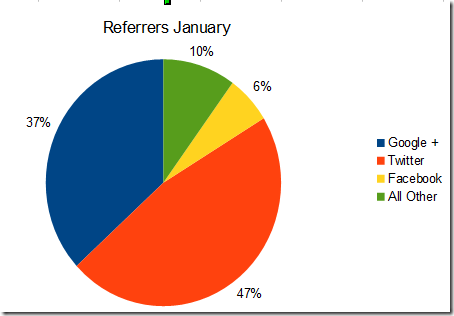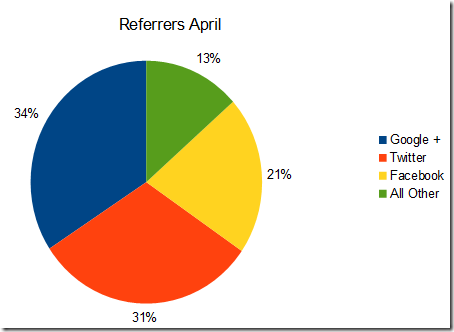Robin D. Laws's Blog, page 82
April 20, 2012
Facebook Bounces Back
 If you’re seeking proof that a few months is an eternity in social media land, check this out.
If you’re seeking proof that a few months is an eternity in social media land, check this out.
Back in January, I reported that Facebook’s share of referrals to this here blog had dwindled dramatically, compared to Twitter and the still baby-fresh Google+. Here’s a snapshot of a week’s traffic from back then:
Now, a week from April shows a dramatically different story:
Overall traffic was the same then as now. It’s the shares that have shifted. Google+’s share has slipped only three points from January. At the same time, referrals from non social media sources, chiefly Google searches, have popped up by exactly that much.
Facebook’s gain is Twitter’s pain. It’s up by 15 points, and Twitter is down by 16.
Given the symmetry, I’m assuming that the same people who used to be coming here from Twitter are now back to doing it from Facebook. My guess is that Facebook’s alterations to its news feed algorithm has restored links to their former prominence and allure. If so, it shows how much difference the constant tweaking of the Facebook interface can make from one adjustment to the next. What seems like a force to write off in January can bounce back to its old self by April.
April 19, 2012
New Tales of the Yellow Sign Cover Reveal
 Progress in moving New Tales of the Yellow Sign from MS to publication continues, with an exciting announcement to come. Lucya Szachnowski has done a bang-up job on the all-important proofreading.
Progress in moving New Tales of the Yellow Sign from MS to publication continues, with an exciting announcement to come. Lucya Szachnowski has done a bang-up job on the all-important proofreading.
My test of the e-publishing waters with the free short story The Star Makers has proven educational. Some things you can only learn by doing. For example, I’ve discovered how long the Smashwords approval process is—now at a month and counting.
Also long past due—my giving you a peek at the cover illustration by Jérôme Huguenin. Due to Jérôme’s policy of outdoing himself, Jérôme has outdone himself on this one. Check out this creepy contemporary take on Robert W. Chambers’ pallid mask motif. I couldn’t be more delighted. In a horror sort of way, of course.

April 18, 2012
The Birds: Blocked
April 17, 2012
Five Reasons to Fear Quandos Vorn
 During character generation, after determining why they want vengeance against the common enemy called Quandos Vorn, Gaean Reach players specify why catching up with him will prove a task of epic difficulty. Each supplies a reason of particular relevance to his own motivations and backstory. In the in-house playtest, it was determined that Quandos Vorn:
During character generation, after determining why they want vengeance against the common enemy called Quandos Vorn, Gaean Reach players specify why catching up with him will prove a task of epic difficulty. Each supplies a reason of particular relevance to his own motivations and backstory. In the in-house playtest, it was determined that Quandos Vorn:
maintains a troop of elite cloned bodyguards
constantly disguises himself and is constantly on the move
controls, through corruption, resources even within the IPCC (interstellar police force)
can track one of the PCs’ movements and can't be surprised
constructs elaborate schemes which repeatedly ensnare another of the PCs
This not only further defines their nemesis, but again proves that, given a measure of narrative control, players will screw themselves over in ways they would never permit were a mere GM doing it.
April 16, 2012
When In Doubt, Remind Him He’s a Dwarf
 Welcome again to Scene Study, where we break down dramatic scenes in recent popular entertainment as they might play out in DramaSystem.
Welcome again to Scene Study, where we break down dramatic scenes in recent popular entertainment as they might play out in DramaSystem.
In the Game of Thrones episode “The Night Lands” (Season Two, Episode 2) [stop here if you don’t want to know] Tyrion Lannister tries to assert his new authority as the king’s right hand over his contemptuous and headstrong sister Cersei, regent and mother to the young king. After a power play in which he banishes her chosen head of the city guard in favor of his own candidate, he renews his effort to school her in the politic realities of her tenuous position. Unfortunately, his default tactic, the deployment of withering wit, proves less than effective in this case. After a snide reference to her incestuous relationship with their brother Jamie, she furiously excoriates him—blaming him for their mother’s death giving birth to him, and once again reminding him that he’s a dwarf.
If Tyrion’s player is the scene caller, his intention is to extract a concession from Cersei, admitting that he deserves and is equipped to use the power their father has vested in him. Cersei refuses to grant his petition, so he gets a drama token as a consolation.
If Cersei’s player is the caller, her intention is to browbeat the upstart Tyrion, earning an apology and continuing free reign at court. Despite the virulence of her outburst, he blocks her as surely as she blocks him. In this framing, it is Cersei as refused petitioner who gets the drama token.
April 13, 2012
Crunch v. Fluff: The Unstackening
 On Wednesday I unloaded both barrels on the crunch vs. fluff dichotomy in roleplaying design, labeling it a stacked framing meant to grant an air of objective authority on one set of gamer tastes. Monte Cook, whose post inspired that one, doesn’t much care for the terms either.
On Wednesday I unloaded both barrels on the crunch vs. fluff dichotomy in roleplaying design, labeling it a stacked framing meant to grant an air of objective authority on one set of gamer tastes. Monte Cook, whose post inspired that one, doesn’t much care for the terms either.
Which raises the question: is there a neutral way to describe this real separation in player tastes?
To do that, we need to find positive terms for both ends of the continuum, which respect the essential role they play in a roleplaying experience, and the players who strongly prefer one side over the other.
“Crunch” works as is, as one would expect for the quality the framing was built to favor. I used the related term “crunchy bit” in Robin’s Laws of Good Game Mastering to evoke the satisfying interplay of imaginary hard details. There is an aesthetic pleasure in these interactions, both as abstractions and in the ways they claim to simulate real-world processes. Players find a certain complexity level emotionally satisfying. Inconveniently for game designers, that level varies even among crunch-lovers. Crunch also suggests what one tends to do with these rules—crunch your opponents upside the head. It appeals to particular player types, placing vital tools in the hands of butt-kickers, tacticians, and power gamers.
“Fluff”, however, has to go. It’s inherently dismissive of the RPG elements that bring storytellers, method actors, explorers and casual gamers to the table. We need a punchy, fun term to encompass the invented histories, character portrayals, setting descriptions, visual imagery and other imaginative elements that together make up the form’s narrative side. “Imagination” or “visualization” describe what these bring to the game, but sound dry and lack that one-syllable pizazz.
In exceptions-based card games, one sometimes uses the term “chrome.” That sounds cool and shiny, but, like “fluff”, implies a superficial layer placed on top of the true substance. Which is arguably the case with the art, flavor text and setting elements in a card game, which are much less central to play in a card game than their analogues in an RPG.
The term “flavor” gets us a little closer. Who would want food without flavor? But it still sounds like an added ingredient rather than one half of a balanced whole.
With a little free association, however, we can springboard from “flavor” and “chrome” to two possible alternate terms.
“Sizzle” seems at least as cool as crunch, and sticks with the latent food metaphor. It draws out the emotional dash that story elements provide.
The judges will also accept “flash” as a short, positive word that describes that selfsame impact.
So if you want to speak honestly when discussing the balance of mechanics/tactics and character/story, call it “crunch vs. sizzle” or “crunch vs. flash.” Then we can talk.
April 12, 2012
The Birds: Jokes
April 11, 2012
False Dichotomy, or Real, Though Annoying, Dichotomy?
 Apropos of his participation in a recent panel discussion, Monte Cook contemplates the opposition between crunch and fluff in roleplaying games. He comes to several wise conclusions, including that the fun side of any argument is whichever one will allow you to debate Jonathan Tweet. Where the central question is concerned, he says:
Apropos of his participation in a recent panel discussion, Monte Cook contemplates the opposition between crunch and fluff in roleplaying games. He comes to several wise conclusions, including that the fun side of any argument is whichever one will allow you to debate Jonathan Tweet. Where the central question is concerned, he says:
I really do think it's a false dichotomy. I think that, for whatever reason having to do with human nature, people like to take parts of a whole and declare favorites, or rank importance. But the dichotomy is often false. To declare that the chips in chocolate chip cookies are more important than the cookie is to ignore the beautiful synthesis of chocolate and cookie. A handful of chocolate chips is okay, but all melty inside a freshly baked, still warm cookie? That's much better.
I wish that crunch vs. fluff was a false dichotomy, but unfortunately it's not, in that it reflects a genuine and hard-to-bridge gap between player taste groups. To extend Monte's metaphor past its sell-by date, we as game designers are trying to create the perfect chocolate chip recipe for a crew of eaters, some of whom like both dough and chocolate, a vocal faction who only care about the cookie, and a counterpart group that barely tolerates the chocolate.
You can see the opposition at work in the framing itself: "crunch vs. fluff" is not only a frustrating dichotomy, but a stacked one. The terms (which Monte doesn't like either) presuppose that character, setting and emotional elements are just fluff—a disposable, if not useless outer layer on top of the real stuff, the crunch.
A similar, older framing is likewise stacked, in the other direction. The old "roleplaying vs. roll-playing" opposition sought to privilege character portrayal over a focus on mechanics and tactics.
Like so many other conceptual frameworks people have devised to describe their RPG experiences, both "crunch vs. fluff" and "roleplaying vs. roll-playing" are definitional gambits meant to lend taste preferences the appearance of objective superiority. They legitimize the parts of play that the framer likes and delegitimize the bits that bore him.
If this was just a false dichotomy, we could argue people out of it, and teach them all to enjoy the entire cookie, like most of the player base does. Really, though, one small but significant chunk of the player base comes alive only for the rulesy stuff, and another digs only the narrative bits.
When designing for a niche audience, you can sidestep the issue by cranking the dial to one side of the spectrum or the other. Monte, along with the rest of the DNDNext team, faces the challenge that comes with the stewardship of roleplaying's flagship product—to strike the ideal balance between the two tendencies.
April 10, 2012
Five Reasons to Hate Quandos Vorn
 With Hillfolk in outside playtest and on the brink of a crowdfunding campaign, I'm now in the early stages of The Gaean Reach, Pelgrane's game of interstellar vengeance, based on the classic cycle of SF novels by Jack Vance. While I originally thought this would be a Skulduggery variant with some GUMSHOE grafted on, it turns out to be the other way around: GUMSHOE with a touch of Skulduggery.
With Hillfolk in outside playtest and on the brink of a crowdfunding campaign, I'm now in the early stages of The Gaean Reach, Pelgrane's game of interstellar vengeance, based on the classic cycle of SF novels by Jack Vance. While I originally thought this would be a Skulduggery variant with some GUMSHOE grafted on, it turns out to be the other way around: GUMSHOE with a touch of Skulduggery.
The game's default campaign frame pits the characters against a nemesis, who they hunt by increments over the course of the series. Every group defines its own nemesis, usually called Quandos Vorn. During character creation, each player indicates what Quandos Vorn did to incur his or her PC's wrath. This delineates both the nemesis and the player character.
In the in-house game, this is why the protagonists plot revenge against Quandos Vorn:
"After I critiqued his academic paper, he saw to it that I lost everything—my tenure, even my family."
"I used to be a corrupt interstellar cop on his payroll, until he killed my partner and framed me for a series of crimes I didn't commit."
"When my casino would not accommodate his obscene requests, Quandos Vorn shut it down."
"His ponzi scheme collapsed the star-spanning financial empire I was supposed to one day inherit."
"To keep himself sharp, Quandos Vorn hunts, battles, and kills clones of himself. The only clone to ever survive one of these pursuits, I seek to avenge the humiliating defeat that left me hideously disfigured."
From those five statements, we know much about Quandos Vorn's behavior and capabilities—and even more about the people who seek him.
April 5, 2012
Angry Cleaning in Lingerie
 Welcome to another installment of Scene Study, where we break down dramatic scenes in recent popular entertainment as they might play out in DramaSystem.
Welcome to another installment of Scene Study, where we break down dramatic scenes in recent popular entertainment as they might play out in DramaSystem.
In the Mad Men season opener [stop reading here if you don't want to know], Don Draper and his new wife Megan find themselves at odds after she embarrasses him with a surprise party, at which she performs a suggestive yeh yeh number. The next day, discovering that she's left work, Don heads to their new apartment to have it out with her. Megan puts him on the defensive with a bizarre tactic—lashing out in anger while simultaneously shucking her house coat to clean up the still-trashed apartment clad only in sexy lingerie. Taken aback, and then finally overcome with desire, Don jumps on her. Cut to: post-coital reconciliation.
In DramaSystem terms, Don is the petitioner—he's the one whose desire for an emotional concession from Megan kicks off the scene. Megan proves an aggressive granter, throwing Don off by presenting him with bold emotional demands of her own.
Were I playing Don Draper, I'd score the result as refusal of the petition, earning me a drama token. I wanted to get my power back from my surprisingly formidable young bride, and instead established her power over me. Another player might score it as a granting of the petition, earning Megan's player a drama token. In this view, Don wanted to reconnect with Megan, and she let him, in a way that saved face for both of them. Given the apparent direction of the new season, which might be sub-titled "Don Gets Old", both Matthew Weiner and I might disagree with you. But in DramaSystem, the petitioner's player is always free to specify that his petition was granted, whether the GM and the rest of the group agree or not.







